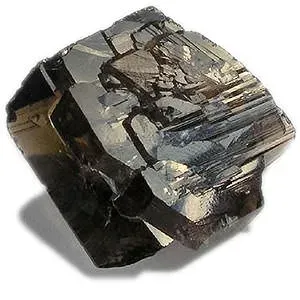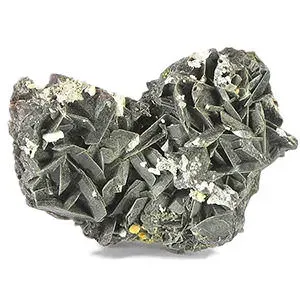 Axinite is a complex calcium and aluminum borosilicate. Its name derives from the Greek word axine, meaning axe, a reference to the crystals' very sharp edged, axe-head shapes. Axinite crystals are rarely cut as gemstones and are usually only faceted for collectors. While they are beautiful and hard, they are also brittle and have a very low clarity. However, because of their excellent luster and well-formed flattened crystals, they are commonly collected as mineral specimen.
Axinite is a complex calcium and aluminum borosilicate. Its name derives from the Greek word axine, meaning axe, a reference to the crystals' very sharp edged, axe-head shapes. Axinite crystals are rarely cut as gemstones and are usually only faceted for collectors. While they are beautiful and hard, they are also brittle and have a very low clarity. However, because of their excellent luster and well-formed flattened crystals, they are commonly collected as mineral specimen.
 Other members of the axinite group of minerals have the same structure as axinite, but differ in chemical composition. These include the magnesium-rich magnesio-axinite, a pale blue color, manganaxinite, a yellow-orange color, the iron-rich ferro-axinite, a lilac brown color, and the most common family member, the iron and manganese-rich tinzenite, which is yellow. Dark brown colored axinite has often been confused with smoky
Other members of the axinite group of minerals have the same structure as axinite, but differ in chemical composition. These include the magnesium-rich magnesio-axinite, a pale blue color, manganaxinite, a yellow-orange color, the iron-rich ferro-axinite, a lilac brown color, and the most common family member, the iron and manganese-rich tinzenite, which is yellow. Dark brown colored axinite has often been confused with smoky ![]() quartz.
quartz.
 Axinite rates a 7 on the hardness scale and has a vitreous luster. It is transparent to translucent. Axinite crystals are normally brown, a result of the high iron content of the stone. When the stone is pale blue in color, it is a result of low iron content. Axinite can also be found, however, in colors ranging from clove brown to yellowish to gray, as well as in different shades of purple, most often a beautiful plum purple color. There is also a rare form of axinite that comes from Tanzania, which is a stunning shade of blue. Axinite is also strongly pleochroic, displaying a mixture of such colors as olive green, plum red, and cinnamon brown. Normally, axinite crystals are broad with sharp edges, but they can also be massive, lamellar, or granular. Axinite's associated minerals include
Axinite rates a 7 on the hardness scale and has a vitreous luster. It is transparent to translucent. Axinite crystals are normally brown, a result of the high iron content of the stone. When the stone is pale blue in color, it is a result of low iron content. Axinite can also be found, however, in colors ranging from clove brown to yellowish to gray, as well as in different shades of purple, most often a beautiful plum purple color. There is also a rare form of axinite that comes from Tanzania, which is a stunning shade of blue. Axinite is also strongly pleochroic, displaying a mixture of such colors as olive green, plum red, and cinnamon brown. Normally, axinite crystals are broad with sharp edges, but they can also be massive, lamellar, or granular. Axinite's associated minerals include ![]() quartz, calcite, andradite,
quartz, calcite, andradite, ![]() garnet, diopside, epidote, scheelite, and prehnite.
garnet, diopside, epidote, scheelite, and prehnite.
 Axinite is found in cavities in granite and in calcareous rocks that have undergone contact metamorphism and metasomatism. It can be found all over the world. Honey yellow crystals are found in the United States, in New Jersey. Various other colors of axinite are found in Mexico, Australia, Russia, Brazil, and Switzerland. The largest quantities of axinite are found in the gravels of Sri Lanka, around St. Just, Cornwall, in southwest England, at Bourg d'Oisans, Isere, in eastern France, Timiskaming, Ontario, in Canada, Sauerland, North Rhine-Westphalia, in western Germany, and in the Erzegebirge mountains in eastern Germany.
Axinite is found in cavities in granite and in calcareous rocks that have undergone contact metamorphism and metasomatism. It can be found all over the world. Honey yellow crystals are found in the United States, in New Jersey. Various other colors of axinite are found in Mexico, Australia, Russia, Brazil, and Switzerland. The largest quantities of axinite are found in the gravels of Sri Lanka, around St. Just, Cornwall, in southwest England, at Bourg d'Oisans, Isere, in eastern France, Timiskaming, Ontario, in Canada, Sauerland, North Rhine-Westphalia, in western Germany, and in the Erzegebirge mountains in eastern Germany.